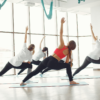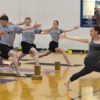- July 1, 2016
- Umang Goel
- Blog
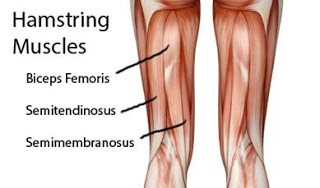
Let’s make some serious commitment to our Hamstrings for visible, lasting and fast results and through path of least resistance especially during Wellness Haven Sunday Workshops open to all Wellness Haven Students.
Hamstrings flexibility is very important in our mobility. The hamstrings play a crucial role in many daily activities, such as, walking, running, jumping, and controlling some movement in the trunk. Stretching of hamstrings comes in handy in a variety of sports besides yoga.
Let’s take a closer look at the anatomy of hamstring muscles.
A hamstring is any of the three tendons contracted by three posterior thigh muscles: semitendinosus, semimembranosus and biceps femoris (long & short head). All of these muscles flex and bend the knee. The three ‘true’ hamstrings cross both the hip and the knee joint and are therefore involved in knee flexion and hip extension. All but the short head of biceps extend and straighten the hip. The short head of the biceps femoris crosses only one joint/knee and is therefore not involved in hip extension. Each originates/attaches on the sitting bones of the pelvis, and runs down the back of the thigh. There are two hamstrings on the medial/inner side of the back of the thigh, and one on the lateral/outer side; all three attach by long tendons crossing the back of the knee to the lower leg.
Semitendinosus and semimembranosus extend the hip when the trunk is fixed; they also flex the knee and medially/inwardly rotate the lower leg when the knee is bent. The long head of the biceps femoris extends the hip as when beginning to walk; both short and long heads flex the knee and laterally (outwardly) rotates the lower leg when the knee is bent.
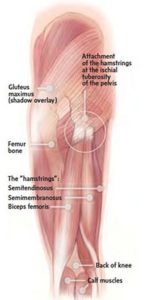
Hamstrings
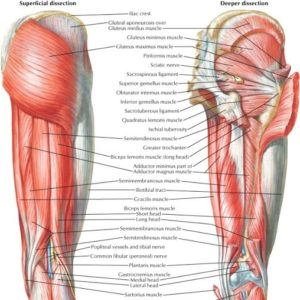
Anatomy of Hamstrings
Weakness and Tightness in Hamstrings
Weak and Tight Hamstrings can cause a lot of pain and especially a very painful lower back. When we experience no resistance in our hamstrings we say we have flexible hamstrings.
Some indications to the degree of tightness in hamstrings can be found through the following actions:
– can you touch your toes with your fingertips with no bend in the knees in standing position?
– can you touch your toes with the palm on the ground with no bend in the knees in standing position?
– can you touch your toes with the palm on the ground, and with elbows bent, with no bend in the knees in standing position?
Testing flexibility in hamstrings also come from the ability to reach the fingers to the toes in seated asana with squared shoulders and hips. Note that forced stretches bring a high possibility of injured lower back. This is especially evident when one tries to reach the toes in seated forward fold or Janu Sirsasana by managing to do it by compromising the body through spinal twist or move the leg to allow the lateral hamstrings to shorten.
Learning to use Hamstrings
Most people simply don’t know where to start when it comes to working on hamstrings flexibility and even years of stretching leaves us wondering why we are so tight in-spite of exercising, unless we learn the focused muscle stretching and flexing methods. We may all know which yoga poses stretches which hamstrings and we are listing some below for you, but focused muscle techniques are needed even before we can get comfortably into these yoga poses and we apply such methods in our Sunday workshops. For example Lateral Hamstrings (Biceps Femoris) is one of larger hurdles to the True Front Split with squared hips and stretches need to be focused on this particular muscle.
Yoga poses for Central Hamstrings:
Forward folds with the feet hip width distance apart will stretch the central portion of the hamstrings. These include Paschimottanasana / Seated Forward Fold, Uttanasana / Standing Forward Fold , Halasana / Plow Pose.
Yoga Poses for Outer Hamstrings:
Pasvottanasana / Intense Side Stretch), Parivrtta Trikonasana / Revolved Traingle Pose
Urgency of Warm-Ups
We all know how critical warm-up exercises are before any yoga asana. But even after the warm-up, the real benefit is in staying or maintaining power of the stretch. In general people do not want to stay in a stretch for various reasons such as:
1. too much of hurry all the time is a part of their personality
2. no real awareness of what it takes to benefit from the pose completely
3. they do not ease into the stretch gently and slowly and only to the point that the body is comfortable on a particular day/time, and experience tremendous tightness leading them to coming out of the pose in a hurry.
Such behavior patterns are especially who practice asanas irregularly versus at least every alternate day. Unfortunately each time they practice the asana, they have to start from ground zero. that is the very place they started the first time.
Let’s lengthen our hamstrings one-baby-step-at-a-time at Wellness Haven Yoga. Reach out to us if you really want to open up your body parts and not just ‘exercise’ : (925)819-6327
Wellness Haven Yoga Classes






